Flowers have enchanted us for centuries with their captivating beauty and fragrant scents. Each flower has its unique charm and appeal that never fails to captivate our hearts. If you’re a flower enthusiast looking for inspiration to brighten your garden or home decor, you’re in luck. This article will explore 20 enchanting flowers starting with E, that will surely delight you with their charm and elegance. From the exquisite English Lavender to the exotic Escallonia, we’ll delve into each flower’s unique characteristics, symbolism, and uses. So, grab a cup of coffee, sit back, and get ready to immerse yourself in the wonderful world of flowers, starting with E.
Why Should I Use Enchanting Flowers Starting With E?
Well, my dear gardening friend, let me tell you why you should use enchanting flowers, starting with E. For starters, they’re like a magical spell that can instantly elevate your mood and transform any space into a paradise. They’re the perfect antidote for a bad day or a dull room that needs a splash of color and life.
But that’s not all! Did you know that many of these flowers have symbolic meanings that can add depth and significance to your gift or decor? For example, the Easter Lily is associated with purity and hope, while the Everlasting Flower represents immortality and eternal love. Who knew that a simple flower could pack such a powerful message?
Plus, let’s remember the practical benefits of using enchanting flowers, starting with E. Many of these flowers, such as the Eucalyptus, have medicinal properties that can help with respiratory problems and inflammation. And if you’re looking to attract bees and butterflies to your garden, the Echinacea and English Lavender are known to do just that!
So, whether you want to add charm and whimsy to your home or express your heartfelt emotions through a thoughtful gift, enchanting flowers starting with E is the way to go. They’re like a little bit of magic in a vase or garden bed, and who doesn’t need a little magic in their life?
1. Easter Lily
Easter Lily, scientifically known as Lilium longiflorum, is a popular flowering plant that is cherished for its beauty and symbolism. It is a perennial plant that belongs to the Liliaceae family and is native to the Ryukyu Islands in southern Japan.

Colors: Easter Lilies are known for their pure white color, which is associated with purity, innocence, and hope. The white petals are trumpet-shaped and have a subtle fragrance that is reminiscent of the spring season.
Planting Tips: If you’re planning to grow Easter Lilies in your garden, there are a few things you need to keep in mind. Firstly, they prefer well-drained soil that is rich in organic matter. Secondly, they need to be planted in a location that receives full sun exposure, although they can tolerate partial shade. Lastly, Easter Lilies should be planted in the fall or early winter to ensure that they bloom in the spring.
Ideal Locations: Easter Lilies can be grown both indoors and outdoors, depending on your preference. If you’re growing them indoors, make sure to place them in a bright, sunny location that receives indirect light. Outdoors, they are ideal for borders, rock gardens, or as potted plants on your patio or deck.
Major Countries: Easter Lilies are primarily grown in Japan, Taiwan, and the United States. In the US, the state of Oregon is the leading producer of Easter Lilies, accounting for over 90% of the bulbs sold in the country.
In conclusion, Easter Lilies are a beautiful and meaningful flowering plant that can add a touch of elegance and grace to any space. With proper care and attention, they can bloom year after year, filling your garden or home with their stunning beauty and fragrance.
2. English Lavender
English Lavender, scientifically known as Lavandula angustifolia, is a beloved flowering plant that is known for its fragrant aroma and beautiful blooms.
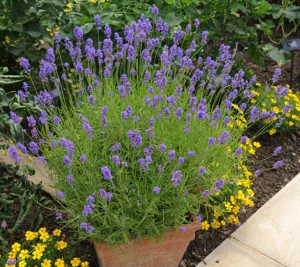
Colors: English Lavender is known for its stunning violet-blue flowers, although they can also range from white to pink depending on the variety. The flowers are arranged in spikes and have a sweet, floral fragrance that is associated with relaxation and calmness.
Planting Tips: If you’re planning to grow English Lavender in your garden, there are a few things you need to keep in mind. Firstly, they prefer well-drained soil that is alkaline or neutral. Secondly, they need to be planted in a location that receives full sun exposure, as they do not tolerate shade well. Lastly, English Lavender should be pruned regularly to promote bushier growth and prevent the plant from becoming woody.
Ideal Locations: English Lavender can be grown both indoors and outdoors, depending on your preference. If you’re growing them indoors, make sure to place them in a sunny location that receives at least 6-8 hours of sunlight per day. Outdoors, they are ideal for borders, rock gardens, or as potted plants on your patio or deck.
Major Countries: English Lavender is native to the Mediterranean region but is now grown worldwide. Some of the major countries where English Lavender is grown include France, Spain, Italy, England, and the United States.
In conclusion, English Lavender is a beautiful and fragrant plant that can add a touch of elegance and charm to any garden or home. With proper care and attention, they can bloom year after year, filling your space with their sweet scent and beautiful blooms.
3. Edelweiss
Edelweiss, scientifically known as Leontopodium alpinum, is a beautiful and unique flowering plant that is native to the European Alps.
Colors: Edelweiss is known for its stunning white or yellowish-white flowers, which are arranged in clusters and have a soft, velvety texture. The flowers are star-shaped and have a unique, almost otherworldly appearance.
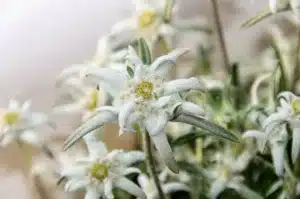
Planting Tips: If you’re planning to grow Edelweiss in your garden, there are a few things you need to keep in mind. Firstly, they prefer well-drained soil that is alkaline or neutral. Secondly, they need to be planted in a location that receives full sun exposure, although they can tolerate partial shade. Lastly, Edelweiss should be watered sparingly, as they do not like to sit in water.
Ideal Locations: Edelweiss is a cold-hardy plant that is ideal for alpine gardens, rock gardens, or as a potted plant on your patio or balcony. They are also great for adding a unique touch to floral arrangements and bouquets.
Major Countries: Edelweiss is primarily found in the European Alps, including Switzerland, Austria, France, and Italy. It is a symbol of national pride for many of these countries and is often associated with the rugged beauty and natural splendor of the Alps.
In conclusion, Edelweiss is a beautiful and unique flowering plant that can add a touch of alpine charm and elegance to any garden or floral arrangement. With proper care and attention, they can bloom year after year, filling your space with their delicate beauty and soft texture.
4. Echinacea
Echinacea, scientifically known as Echinacea purpurea, is a stunning flowering plant that is native to North America.
Colors: Echinacea is known for its striking pink, purple, and white flowers, which are arranged in daisy-like heads and have a distinctive cone-shaped center. The flowers are popular with bees and butterflies, and their colors are associated with healing and tranquility.
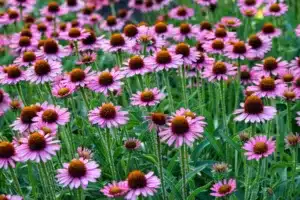
Planting Tips: If you’re planning to grow Echinacea in your garden, there are a few things you need to keep in mind. Firstly, they prefer well-drained soil that is rich in organic matter. Secondly, they need to be planted in a location that receives full sun exposure, although they can tolerate partial shade. Lastly, Echinacea should be watered regularly, but not overwatered, as they do not like to sit in water.
Ideal Locations: Echinacea is ideal for cottage gardens, wildflower gardens, or as a border plant. They are also great for attracting pollinators and adding a pop of color to your garden. In addition, Echinacea is a popular medicinal herb that is used for its immune-boosting and anti-inflammatory properties.
Major Countries: Echinacea is primarily found in North America, including the United States and Canada. It is a popular garden plant and is also cultivated for its medicinal properties.
In conclusion, Echinacea is a beautiful and versatile flowering plant that can add a touch of color and healing to any garden or home. With proper care and attention, they can bloom year after year, filling your space with their striking beauty and natural charm. So, go ahead and give them a try – we promise you won’t be disappointed!
5. Everlasting Flower
Everlasting Flower, scientifically known as Helichrysum bracteatum, is a beautiful and unique flowering plant that is native to Australia.
Colors: Everlasting Flower is known for its striking range of colors, including white, yellow, orange, pink, and red. The flowers are small and have a papery texture, making them ideal for dried floral arrangements and crafts. The flowers are associated with longevity and are often used in wedding bouquets and decorations.

Planting Tips: If you’re planning to grow Everlasting Flower in your garden, there are a few things you need to keep in mind. Firstly, they prefer well-drained soil that is rich in organic matter. Secondly, they need to be planted in a location that receives full sun exposure, although they can tolerate partial shade. Lastly, Everlasting Flower should be watered regularly, but not overwatered, as they do not like to sit in water.
Ideal Locations: Everlasting Flower is ideal for cottage gardens, rock gardens, or as a border plant. They are also great for dried floral arrangements, wreaths, and other crafts. In addition, Everlasting Flower is a popular cut flower that can last for several weeks in a vase or bouquet.
Major Countries: Everlasting Flower is primarily found in Australia, although it is also grown in other parts of the world, including South Africa and the United States. It is a popular garden plant and is also cultivated for its use in the floral industry.
In conclusion, Everlasting Flower is a beautiful and versatile flowering plant that can add a touch of color and longevity to any garden or home. With proper care and attention, they can bloom year after year, filling your space with their striking beauty and natural charm.
6. Eastern Redbud
Eastern Redbud, scientifically known as Cercis canadensis, is a beautiful and unique flowering tree that is native to North America.
Colors: Eastern Redbud is known for its stunning pink or magenta flowers, which bloom in clusters along the branches before the leaves appear in the spring. The flowers are a popular nectar source for bees and other pollinators, and their colors are associated with love and compassion.
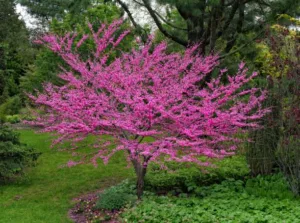
Planting Tips: If you’re planning to grow Eastern Redbud in your garden, there are a few things you need to keep in mind. Firstly, they prefer well-drained soil that is rich in organic matter. Secondly, they need to be planted in a location that receives partial to full sun exposure, although they can tolerate shade. Lastly, Eastern Redbud should be watered regularly, especially during hot, dry weather.
Ideal Locations: Eastern Redbud is ideal for woodland gardens, as an understory tree, or as a focal point in your garden. They are also great for adding a pop of color and interest to your landscape. In addition, Eastern Redbud is a popular ornamental tree that is valued for its beauty and hardiness.
Major Countries: Eastern Redbud is primarily found in North America, including the United States and Canada. It is a popular garden tree and is also grown for its use in landscaping and ornamental horticulture.
In conclusion, Eastern Redbud is a beautiful and unique flowering tree that can add a touch of color and beauty to any garden or landscape. With proper care and attention, they can bloom year after year, filling your space with their stunning pink or magenta flowers and natural charm.
7. Evening Primrose
Evening Primrose, scientifically known as Oenothera biennis, is a beautiful and unique flowering plant that is native to North and South America.
Colors: Evening Primrose is known for its stunning yellow flowers, which bloom in the evening and have a sweet, citrus-like fragrance. The flowers are a popular nectar source for moths and other pollinators, and their colors are associated with happiness and positivity.
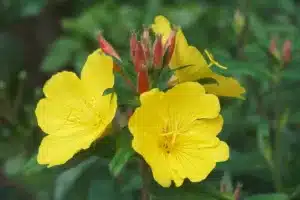
Planting Tips: If you’re planning to grow Evening Primrose in your garden, there are a few things you need to keep in mind. Firstly, they prefer well-drained soil that is rich in organic matter. Secondly, they need to be planted in a location that receives full sun exposure, although they can tolerate partial shade. Lastly, Evening Primrose should be watered regularly, especially during hot, dry weather.
Ideal Locations: Evening Primrose is ideal for wildflower gardens, cottage gardens, or as a border plant. They are also great for adding a pop of color and interest to your landscape. In addition, Evening Primrose is a popular medicinal herb that is used for its anti-inflammatory and analgesic properties.
Major Countries: Evening Primrose is primarily found in North and South America, including the United States, Canada, and Mexico. It is a popular garden plant and is also cultivated for its use in traditional medicine.
In conclusion, Evening Primrose is a beautiful and unique flowering plant that can add a touch of color and beauty to any garden or landscape. With proper care and attention, they can bloom year after year, filling your space with their stunning yellow flowers and sweet fragrance.
8. European Pasqueflower
European Pasqueflower, scientifically known as Pulsatilla vulgaris, is a beautiful and unique flowering plant that is native to Europe and Asia.
Colors: European Pasqueflower is known for its stunning purple, blue, and red flowers, which bloom in early spring before the leaves appear. The flowers are bell-shaped and have a soft, velvety texture. The colors are associated with passion and strength.
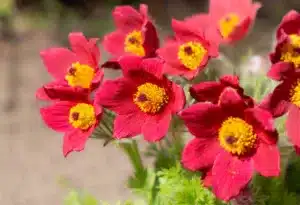
Planting Tips: If you’re planning to grow European Pasqueflower in your garden, there are a few things you need to keep in mind. Firstly, they prefer well-drained soil that is alkaline or neutral. Secondly, they need to be planted in a location that receives full sun exposure, although they can tolerate partial shade. Lastly, European Pasqueflower should be watered sparingly, as they do not like to sit in water.
Ideal Locations: European Pasqueflower is ideal for rock gardens, wildflower gardens, or as a border plant. They are also great for adding a touch of early spring color to your garden. In addition, European Pasqueflower is a popular medicinal herb that is used for its anti-inflammatory and analgesic properties.
Major Countries: European Pasqueflower is primarily found in Europe and Asia, including the United Kingdom, France, Germany, and China. It is a popular garden plant and is also cultivated for its use in traditional medicine.
In conclusion, European Pasqueflower is a beautiful and unique flowering plant that can add a touch of early spring color and beauty to any garden or landscape. With proper care and attention, they can bloom year after year, filling your space with their stunning flowers and natural charm.
9. Erica
Erica, scientifically known as Erica carnea, is a beautiful and unique flowering plant that is native to Europe.
Colors: Erica is known for its stunning pink, white, and purple flowers, which bloom in late winter or early spring. The flowers are bell-shaped and have a delicate, sweet fragrance. The colors are associated with femininity and grace.
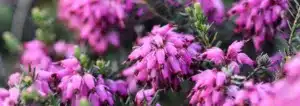
Planting Tips: If you’re planning to grow Erica in your garden, there are a few things you need to keep in mind. Firstly, they prefer well-drained soil that is acidic. Secondly, they need to be planted in a location that receives full sun exposure, although they can tolerate partial shade. Lastly, Erica should be watered sparingly, as they do not like to sit in water.
Ideal Locations: Erica is ideal for rock gardens, alpine gardens, or as a potted plant on your patio or balcony. They are also great for adding a touch of winter color to your garden. In addition, Erica is a popular cut flower that can last for several weeks in a vase or bouquet.
Major Countries: Erica is primarily found in Europe, including the United Kingdom, France, Germany, and the Netherlands. It is a popular garden plant and is also cultivated for its use in the floral industry.
In conclusion, Erica is a beautiful and unique flowering plant that can add a touch of winter color and beauty to any garden or landscape. With proper care and attention, they can bloom year after year, filling your space with their stunning flowers and delicate fragrance.
10. Euonymus
Euonymus, commonly known as Spindle or Spindle tree, is a beautiful and unique flowering plant that is native to Asia, Europe, and North America.
Colors: Euonymus is known for its stunning foliage, which can range in color from green to yellow, orange, pink, and red. The leaves are arranged in opposite pairs and have a distinctive shape, which gives the plant its common name “Spindle tree.” Some species of Euonymus also produce small, inconspicuous flowers.
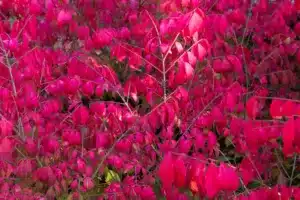
Planting Tips: If you’re planning to grow Euonymus in your garden, there are a few things you need to keep in mind. Firstly, they prefer well-drained soil that is moist but not waterlogged. Secondly, they need to be planted in a location that receives partial to full sun exposure, although they can tolerate shade. Lastly, Euonymus should be watered regularly, especially during hot, dry weather.
Ideal Locations: Euonymus is ideal for hedges, screens, or as a specimen plant in your garden. They are also great for adding a pop of color and interest to your landscape. In addition, Euonymus is a popular plant for bonsai cultivation.
Major Countries: Euonymus is found in Asia, Europe, and North America, including China, Japan, Korea, the United States, and the United Kingdom. It is a popular garden plant and is also cultivated for its use in traditional medicine.
In conclusion, Euonymus is a beautiful and unique flowering plant that can add a touch of color and interest to any garden or landscape. With proper care and attention, they can thrive and enhance the natural beauty of your outdoor space.
11. Enkianthus
Enkianthus, commonly known as Redvein Enkianthus or Enkianthus campanulatus, is a beautiful and unique flowering shrub that is native to Japan, China, and Taiwan.
Colors: Enkianthus is known for its stunning bell-shaped flowers, which can range in color from white to pink, red, and even green. The flowers are often clustered in groups of three and have delicate, frilly edges. In the fall, the leaves of Enkianthus turn vibrant shades of orange, red, and yellow, making it a popular choice for autumn gardens.
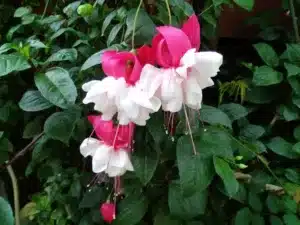
Planting Tips: If you’re planning to grow Enkianthus in your garden, there are a few things you need to keep in mind. Firstly, they prefer well-drained soil that is slightly acidic. Secondly, they need to be planted in a location that receives partial to full sun exposure, although they can tolerate shade. Lastly, Enkianthus should be watered regularly, especially during hot, dry weather.
Ideal Locations: Enkianthus is ideal for woodland gardens, as a border plant, or as a specimen plant in your garden. They are also great for adding a pop of color and interest to your landscape. In addition, Enkianthus is a popular plant for bonsai cultivation.
Major Countries: Enkianthus is primarily found in Japan, China, and Taiwan. It is a popular garden plant and is also cultivated for its use in traditional medicine.
In conclusion, Enkianthus is a beautiful and unique flowering shrub that can add a touch of color and interest to any garden or landscape. With proper care and attention, they can thrive and enhance the natural beauty of your outdoor space.
12. Erythronium
Erythronium, commonly known as Dog’s Tooth Violet or Trout Lily, is a beautiful and unique flowering plant that is native to North America, Europe, and Asia.
Colors: Erythronium is known for its stunning flowers, which can range in color from white to pink, yellow, and even red. The flowers are often bell-shaped and have delicate, frilly edges. The leaves of Erythronium are also striking, with distinct patterns of green and brown, making them a popular choice for woodland gardens.

Planting Tips: If you’re planning to grow Erythronium in your garden, there are a few things you need to keep in mind. Firstly, they prefer well-drained soil that is rich in organic matter. Secondly, they need to be planted in a location that receives partial to full shade, as they are adapted to growing in woodland environments. Lastly, Erythronium should be watered regularly, especially during the growing season.
Ideal Locations: Erythronium is ideal for woodland gardens, as an understory plant, or as a groundcover. They are also great for adding a pop of color and interest to your landscape. In addition, Erythronium is a popular plant for naturalizing, meaning they can be left to grow freely and spread over time.
Major Countries: Erythronium is found in North America, Europe, and Asia, including the United States, Canada, the United Kingdom, and Japan. It is a popular garden plant and is also cultivated for its use in traditional medicine.
In conclusion, Erythronium is a beautiful and unique flowering plant that can add a touch of color and interest to any garden or landscape. With proper care and attention, they can thrive and enhance the natural beauty of your outdoor space.
13. Epimedium
Epimedium, commonly known as Barrenwort or Horny Goat Weed, is a beautiful and unique flowering plant that is native to Asia and Europe.
Colors: Epimedium is known for its delicate, spidery flowers, which can range in color from white to pink, yellow, and even purple. The flowers are often held above the foliage on thin stems, making them a popular choice for rock gardens and borders. The leaves of Epimedium are also striking, with distinct patterns of green and red, making them a popular choice for woodland gardens.
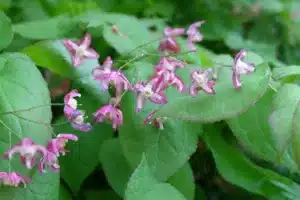
Planting Tips: If you’re planning to grow Epimedium in your garden, there are a few things you need to keep in mind. Firstly, they prefer well-drained soil that is moist but not waterlogged. Secondly, they need to be planted in a location that receives partial to full shade, as they are adapted to growing in woodland environments. Lastly, Epimedium should be watered regularly, especially during the growing season.
Ideal Locations: Epimedium is ideal for woodland gardens, as an understory plant, or as a groundcover. They are also great for adding a pop of color and interest to your landscape. In addition, Epimedium is a popular plant for naturalizing, meaning they can be left to grow freely and spread over time.
Major Countries: Epimedium is found in Asia and Europe, including China, Japan, and the United Kingdom. It is a popular garden plant and is also cultivated for its use in traditional medicine.
In conclusion, Epimedium is a beautiful and unique flowering plant that can add a touch of color and interest to any garden or landscape. With proper care and attention, they can thrive and enhance the natural beauty of your outdoor space.
14. Eucalyptus
Eucalyptus, commonly known as Gum tree, is a beautiful and unique evergreen tree that is native to Australia.
Colors: Eucalyptus is known for its aromatic foliage, which can range in color from green to blue-gray. The leaves are elongated and have a waxy texture, giving the tree a distinctive appearance. The flowers of Eucalyptus are small and inconspicuous, but they are a valuable source of nectar for bees and other pollinators.

Planting Tips: If you’re planning to grow Eucalyptus in your garden, there are a few things you need to keep in mind. Firstly, they prefer well-drained soil that is moderately fertile. Secondly, they need to be planted in a location that receives full sun exposure, as they are adapted to hot and dry environments. Lastly, Eucalyptus should be watered regularly, especially during the growing season.
Ideal Locations: Eucalyptus is ideal for large landscapes, parks, and open spaces, as they can grow up to 300 feet tall. They are also great for providing shade and windbreaks. In addition, Eucalyptus is a popular tree for timber and paper production.
Major Countries: Eucalyptus is primarily found in Australia, but it is also cultivated in other parts of the world, including South Africa, Brazil, and Portugal. It is a popular tree for reforestation and is also cultivated for its use in essential oils and aromatherapy.
In conclusion, Eucalyptus is a beautiful and unique evergreen tree that can add a touch of greenery and interest to any landscape. With proper care and attention, they can thrive and enhance the natural beauty of your outdoor space
15. Eustoma
Eustoma, commonly known as Lisianthus or Prairie Gentian, is a beautiful and unique flowering plant that is native to the southern United States, Mexico, and northern South America.
Colors: Eustoma is known for its stunning bell-shaped flowers, which can range in color from white to pink, lavender, blue, and even purple. The flowers have delicate, frilly edges and a distinctive, almost ethereal quality. The colors are associated with grace, elegance, and refinement.
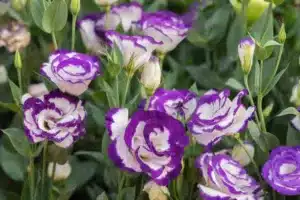
Planting Tips: If you’re planning to grow Eustoma in your garden, there are a few things you need to keep in mind. Firstly, they prefer well-drained soil that is moderately fertile. Secondly, they need to be planted in a location that receives full sun exposure, as they are adapted to hot and dry environments. Lastly, Eustoma should be watered regularly, especially during the growing season.
Ideal Locations: Eustoma is ideal for borders, as a cut flower, or as a specimen plant in your garden. They are also great for adding a pop of color and interest to your landscape. In addition, Eustoma is a popular flower for use in weddings and other special events.
Major Countries: Eustoma is primarily found in the southern United States, Mexico, and northern South America, including Texas, Louisiana, and Brazil. It is a popular garden plant and is also cultivated for its use in the floral industry.
In conclusion, Eustoma is a beautiful and unique flowering plant that can add a touch of color and elegance to any garden or landscape. With proper care and attention, they can thrive and enhance the natural beauty of your outdoor space.
16. Exotic Hibiscus
Exotic Hibiscus, also known as Hibiscus rosa-sinensis, is a beautiful and unique flowering plant that is native to tropical Asia and the Pacific Islands.
Colors: Exotic Hibiscus is known for its stunning trumpet-shaped flowers, which can range in color from white to yellow, orange, pink, red, and even purple. The flowers have a distinctive, almost tropical quality, and are often adorned with a contrasting center. The colors are associated with love, passion, and beauty.
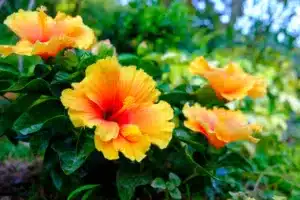
Planting Tips: If you’re planning to grow Exotic Hibiscus in your garden, there are a few things you need to keep in mind. Firstly, they prefer well-drained soil that is moderately fertile. Secondly, they need to be planted in a location that receives full sun exposure, as they are adapted to hot and humid environments. Lastly, Exotic Hibiscus should be watered regularly, especially during the growing season.
Ideal Locations: Exotic Hibiscus is ideal for borders, as a specimen plant, or as a container plant on patios and balconies. They are also great for adding a pop of color and interest to your landscape. In addition, Exotic Hibiscus is a popular plant for tropical and subtropical gardens.
Major Countries: Exotic Hibiscus is primarily found in tropical Asia and the Pacific Islands, including China, India, and Hawaii. It is a popular garden plant and is also cultivated for its use in traditional medicine and as a source of fiber.
In conclusion, Exotic Hibiscus is a beautiful and unique flowering plant that can add a touch of color and tropical flair to any garden or landscape. With proper care and attention, they can thrive and enhance the natural beauty of your outdoor space.
17. Eskimo Viburnum
Eskimo Viburnum, also known as Viburnum ‘Eskimo’, is a beautiful and unique shrub that is native to Japan.
Colors: Eskimo Viburnum is known for its stunning clusters of white flowers, which appear in late spring to early summer. The flowers have a delicate, almost ethereal quality, and are often followed by small red berries. The leaves of Eskimo Viburnum are also striking, with a deep green color and a glossy texture.

Planting Tips: If you’re planning to grow Eskimo Viburnum in your garden, there are a few things you need to keep in mind. Firstly, they prefer well-drained soil that is moderately fertile. Secondly, they need to be planted in a location that receives partial to full sun exposure, as they can tolerate some shade. Lastly, Eskimo Viburnum should be watered regularly, especially during the growing season.
Ideal Locations: Eskimo Viburnum is ideal for borders, as a specimen plant, or as a hedge. They are also great for adding a pop of color and interest to your landscape. In addition, Eskimo Viburnum is a popular plant for use in mixed borders and woodland gardens.
Major Countries: Eskimo Viburnum is primarily found in Japan, but it is also cultivated in other parts of the world, including the United States and the United Kingdom. It is a popular garden plant and is also cultivated for its use in floral arrangements.
In conclusion, Eskimo Viburnum is a beautiful and unique shrub that can add a touch of elegance and interest to any garden or landscape. With proper care and attention, they can thrive and enhance the natural beauty of your outdoor space.
18. Escallonia
Escallonia is a beautiful evergreen shrub that is native to South America.
Colors: Escallonia is known for its stunning clusters of pink, white, or red flowers, which appear in summer and fall. The flowers are often fragrant and attract bees and other pollinators. The leaves of Escallonia are also striking, with a glossy texture and a deep green color.
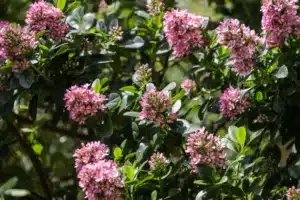
Planting Tips: If you’re planning to grow Escallonia in your garden, there are a few things you need to keep in mind. Firstly, they prefer well-drained soil that is moderately fertile. Secondly, they need to be planted in a location that receives full sun exposure, as they are adapted to hot and dry environments. Lastly, Escallonia should be watered regularly, especially during the growing season.
Ideal Locations: Escallonia is ideal for borders, as a hedge, or as a specimen plant in your garden. They are also great for adding a pop of color and interest to your landscape. In addition, Escallonia is a popular plant for use in coastal gardens, as they can tolerate salt spray and wind.
Major Countries: Escallonia is primarily found in South America, including Chile and Argentina. It is a popular garden plant and is also cultivated for its use in hedges and as a source of nectar for bees.
In conclusion, Escallonia is a beautiful and unique shrub that can add a touch of color and interest to any garden or landscape. With proper care and attention, they can thrive and enhance the natural beauty of your outdoor space.
19. Elephant Ears
Elephant Ears, also known as Colocasia esculenta, is a unique and tropical plant that is native to Southeast Asia and the Pacific Islands.
Colors: Elephant Ears are known for their large, heart-shaped leaves that can grow up to 3 feet in length. The leaves can range in color from green to deep purple, and have a glossy, almost iridescent appearance. In addition, Elephant Ears produce a distinctive spadix, which is a long, fleshy stalk that bears the plant’s flowers.

Planting Tips: If you’re planning to grow Elephant Ears in your garden, there are a few things you need to keep in mind. Firstly, they prefer well-drained soil that is moist and fertile. Secondly, they need to be planted in a location that receives partial to full sun exposure, as they can tolerate some shade. Lastly, Elephant Ears should be watered regularly, especially during the growing season.
Ideal Locations: Elephant Ears are ideal for adding a tropical flair to your garden, patio or balcony. They are also great for adding interest to mixed borders or as a specimen plant. In addition, Elephant Ears are popular for use in water gardens and as an indoor plant.
Major Countries: Elephant Ears are primarily found in Southeast Asia and the Pacific Islands, including India, Malaysia, and Thailand. They are also cultivated in other parts of the world, including the United States and the United Kingdom. Elephant Ears are popular for their use in tropical gardens and as a source of food, as the tubers are edible and commonly used in Asian cuisine.
In conclusion, Elephant Ears are a unique and fascinating plant that can add a touch of tropical paradise to any garden or landscape. With proper care and attention, they can thrive and enhance the natural beauty of your outdoor space.
20. Eggplant Leaf False Heather
The Eggplant Leaf False Heather, also known as Cuphea aequipetala, is a beautiful and unique plant that is native to Mexico and Central America.
Colors: Eggplant Leaf False Heather is known for its stunning, tubular flowers, which can range in color from pink to purple, red, and even orange. The flowers have a distinctive, almost exotic quality, and are often adorned with contrasting markings. The leaves of Eggplant Leaf False Heather are also striking, with a deep green color and an eggplant-like shape.
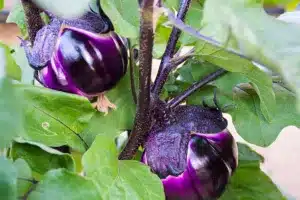
Planting Tips: If you’re planning to grow Eggplant Leaf False Heather in your garden, there are a few things you need to keep in mind. Firstly, they prefer well-drained soil that is moderately fertile. Secondly, they need to be planted in a location that receives full sun exposure, as they are adapted to hot and dry environments. Lastly, Eggplant Leaf False Heather should be watered regularly, especially during the growing season.
Ideal Locations: Eggplant Leaf False Heather is ideal for borders, as a container plant, or as a specimen plant in your garden. They are also great for adding a pop of color and interest to your landscape. In addition, Eggplant Leaf False Heather is a popular plant for use in mixed borders and as a groundcover.
Major Countries: Eggplant Leaf False Heather is primarily found in Mexico and Central America. It is a popular garden plant and is also cultivated for its use in traditional medicine.
In conclusion, Eggplant Leaf False Heather is a beautiful and unique plant that can add a touch of color and interest to any garden or landscape. With proper care and attention, they can thrive and enhance the natural beauty of your outdoor space. So, go ahead and give them a try – we promise you won’t be disappointed!
Final Dirt On Flowers Starting With E
We hope that this article has given you a glimpse into the enchanting world of flowers starting with E. From the classic elegance of the Easter Lily to the unique beauty of the Exotic Hibiscus, there is no shortage of options to choose from when it comes to adding a touch of color and interest to your garden.
If you have any questions about these flowers or any other gardening-related topics, we encourage you to leave a comment below or reach out to us here at Our Gardening World. We’re always happy to help and provide advice to fellow gardening enthusiasts.
Remember, gardening is a rewarding and fulfilling hobby that allows you to connect with nature and create a beautiful outdoor space. With a little patience, care, and attention, you can create a vibrant and thriving garden that will bring joy and beauty for years to come. So go ahead, get your hands dirty, and let your love for gardening grow!

Hi there, I’m Mark Apletree, a gardening enthusiast with a passion for gardening, and gardening tools. I’ll be your go-to guide for all things related to gardening. The purpose of this website is to assist you in selecting the most suitable garden gear that meets your specific requirements.
See All Posts

